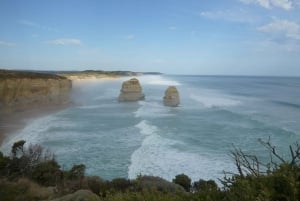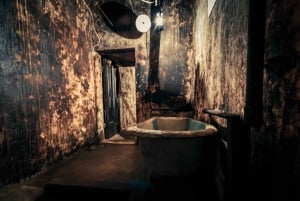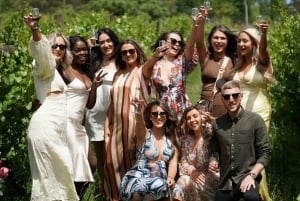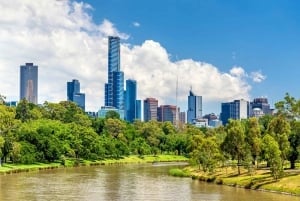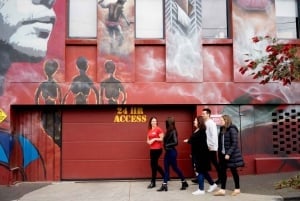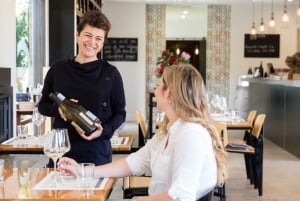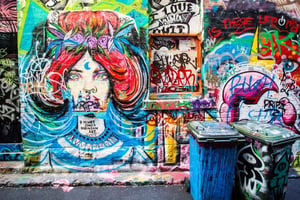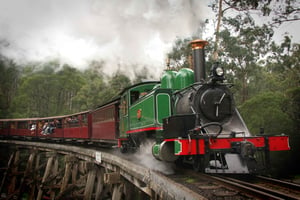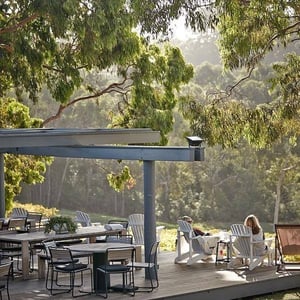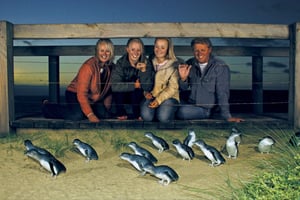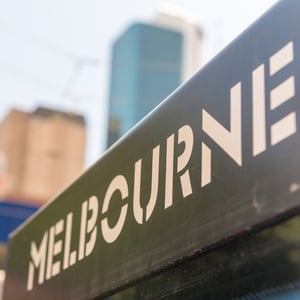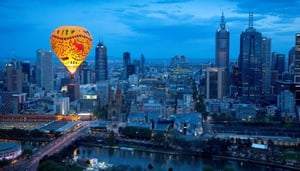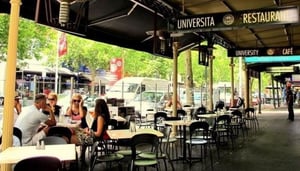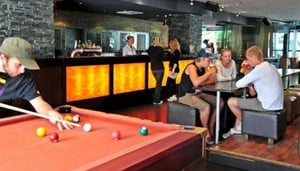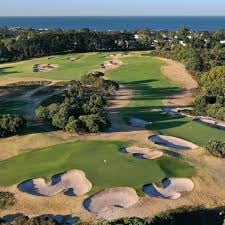Aboriginal Victoria
Book Top Experiences and Tours in Melbourne:
If youʻre booking your trip to Melbourne last minute, we have you covered. Below are some of the top tours and experiences!- From Melbourne: Great Ocean Road, 12 Apostles, Wildlife Tour
- Melbourne Airport: Express Bus Transfer to/from City Center
- From Melbourne: 3-Day Great Ocean Road Tour with Lodging
- Grampians: J Ward Lunatic Asylum Night Ghost Tour
- Melbourne: Yarra Valley Wine, Cider, Gin, Beer, & Choc Tour
Up until today, no one can put an exact figure on the arrival of Aboriginal people on the Australian continent. Estimates vary widely, however, it is most commonly believed that they came from the South East Asian archipelago between 40,000 and 60,000 years ago. With a length of history beyond human imagination, the Aboriginal people of Australia hold the oldest continuous culture in the world.
Aboriginal people did not perceive themselves as one, but rather as many separate clans that lived independently from one another. It is estimated that around 500 such clans inhabited Australia when the first Europeans arrived. In Victoria, it is believed that there were around 38 separate language groupings, and within each of these were many clans.
While not possessing many physical assets, the Aboriginal people had developed a highly complex spiritual system. According to their belief humans are part of the land they live in. Every clan and every person is a direct descendent of those epic ancestor, which created the land and all living creatures during what is vaguely translated as "dreamtime". The story of this creation has been passed on from generation to generation in songs and verses. Every part of the environment, be it a rock, a bush or a sand dune, has its meaning and forms an immovable part of the Aboriginal identity.
In the Aboriginal mindset, current generations are the keepers of the land, rather than its owners. While always living in harmony with their environment, they did impact on their surroundings. To create more sparse and open forests favourable for hunting, the Aboriginals regularly burnt down their hunting grounds. Around 10,000 years ago, they introduced the Dingo, which led to the extinction of the Tasmanian Devil and the Tasmanian Tiger on the Australian continent.
There is evidence that some Aboriginal clans had irregular contacts with Indonesian seafarers for a few hundred years before the arrival of the Europeans. However, nothing could have prepared them for the major invasion of foreigners that they were about to experience.
British colonists declared the Australian continent Terra Nullius – a land that belonged to nobody and could be taken into possession without further ado. They perceived the indigenous people as a primitive race who wandered through the land without establishing permanent settlements or cultivating the land.
Many Aboriginal people fell victim to European diseases, which were entirely new to them. Others were forced to leave the place where their clan had lived for thousands of years. For the Aboriginal people this meant loosing a central part of their identity along with the sources for food and water. Bloody confrontations between indigenous people and British colonists became inevitable and almost always ended fatal for the Aboriginals, who were ill equipped against the weaponry of the foreign invaders. The effects of European colonization were devastating to Aboriginal people around Australia and their number decreased with a dreadful speed.
It wasn't until 1992 that the High Court of Australia overturned the legal fiction of terra nullius. For the first time in history, an Australian court of justice acknowledged that Australia was indeed inhabited when claimed by the British Crown in 1788, and that the rights of Aboriginal people did not cease with European colonization. This legal statement became known as the Mabo Decision.
Today, in Victoria and in other parts of Australia, indigenous land use agreements grant Aboriginal communities the use of the land for a variety of cultural, social and economic activities.
Tribal boundaries are recognised today and are the basis of native title claims under the Commonwealth Government's Native Title Act. In a historic move the Yorta Yorta people lodged the first native title claim in Victoria under this Act in 1993.
Aboriginal people welcome the opportunity to tell visitors about their land and their culture and many communities have established well-organized information centres around traditional sites.
For Aboriginal people land is central to their identities, their heritage and their spiritual existence. The landscape and all the animals, plants and people that inhabit it are an integral part of their spiritual environment.
There are many sites of indigenous significance around Melbourne and Victoria, including ancient camp sites, mission sites, reserves and places where battles and massacres took place.
Among the most important regions are:
Melbourne is a good place to start your exploration of Aboriginal Victoria. The place that is Melbourne today used to be the Kulin Nation, made of the Wurundjeri, Boonerwrung, Taungurong, Djajawurrung and the Wathaurung people. This has always been an important meeting place for the Indigenous people.
The Koorie Heritage Trust Centre on the corner of King Street and Little Lonsdale Street in the CBD is one of the most significant Aboriginal centres in Melbourne. With a collection of artefacts, paintings, photographs and written and oral recordings, the centre preserves the Koori culture. Koori is the local name for the Aboriginal people in this region.
The Bunjilaka is the Aboriginal Cultural Centre at the Melbourne Museum. The exhibition space is currently closed for redevelopment and is expected to reopen in mid 2013.
Local Aboriginal guides take visitors on guided heritage walks through the Royal Botanical Gardens. Along the walk you will learn about the rich heritage of the Boonwurrung and Woiwurrung people and the traditional use of plants and food, medicine, tools and ceremonies.
There is no shortage of Aboriginal art galleries right around Melbourne. Among them are the Gabrielle Pizzi in Flinders Lane, the Aboriginal Galleries of Australia in Spring Steet, the Aboriginal Gallery of Dreamings in Cheltenham, the Alcaston Gallery in Brunswick Street, Fitzroy and the Redrock Gallery at Southgate.
If you're looking for an authentic gift to take home, head to Aboriginal Creations on Bourke Street. The shop sells clothes, handbags, shoes, jewellery, art and souvenirs – all made by Aboriginal artists and designers.
Evidence of a permanent Aboriginal village near Lake Condah has recently earned the site National Heritage status. The village is important evidence against the myth that all Indigenous people of Australia were nomadic. A guided tour takes you to the remains of stone houses, which used to be inhabited by local clans.
The Narana Creations Aboriginal Craft and Cultural Interpretation Centre in Torquay sells authentic, handcrafted Aboriginal items and also runs cultural demonstrations, like didgeridoo performances and boomerang throwings.
Enjoy magnificent views along the Point Addis Koori Cultural Walk while learning about the traditional use of local plants among the Wathaurong, the Aboriginal people that used to live in the Geelong area. Surf Coast Website
The Worn Gundidj Centre hosts a photo exhibition about Tower Hill and the Koori people of the area. It has a little shop selling items handcrafted by Indigenous people.
Gariwerd, or what is now know as the Grampians, has been home to Aboriginal people for at least 5000 years. Surrounded by a wealthy flora and fauna, they lived like in a natural pantry. Next to hunting and other activities aimed at obtaining food, they had enough time to practice their spirituality and arts. The Grampians are home to 80 percent of Aboriginal rock art sites in Victoria.
Among the most significant rock art shelters in the region is Bunjil's shelter near Stawell. Bunjil was known as a good spirit who created things as they are today and gave the tribes their law and culture. The site is surrounded by a hilly landscape, in which you might encounter the odd wallaby or kangaroo if you're lucky.
Brambuk – the National Park & Cultural Centre is dedicated to uncovering the Aboriginal heritage of the region. It hosts a vivid exhibition on the flora, fauna, geology and traditional keepers of the Grampians. The Brambuk Aboriginal Cultural Centre right behind it has been designed as a symbol of the Koori culture. It informs about the life of Aboriginal people before the arrival of the Europeans and their tragic fate during colonization.
The vast Gippsland region has been home to Aboriginal people for tens of thousands of years. The Wilsons Promontory National Park remains a site of spiritual significance for Koorie communities today.
In Bairnsdale, descendants of the local Gunai people have set up the Krowathunkaloong Keeping Place, documenting their history and former way of life.
The centre is part of the Bataluk Cultural Trail, which extends from Sale through the Mitchell River National Park, Bairnsdale, and Orbost to Cape Conran. It follows the trails and trading routes of the local Aboriginal people and connects important historical and cultural sites.
Image Courtesy: Getty Images/Tourism Victoria




